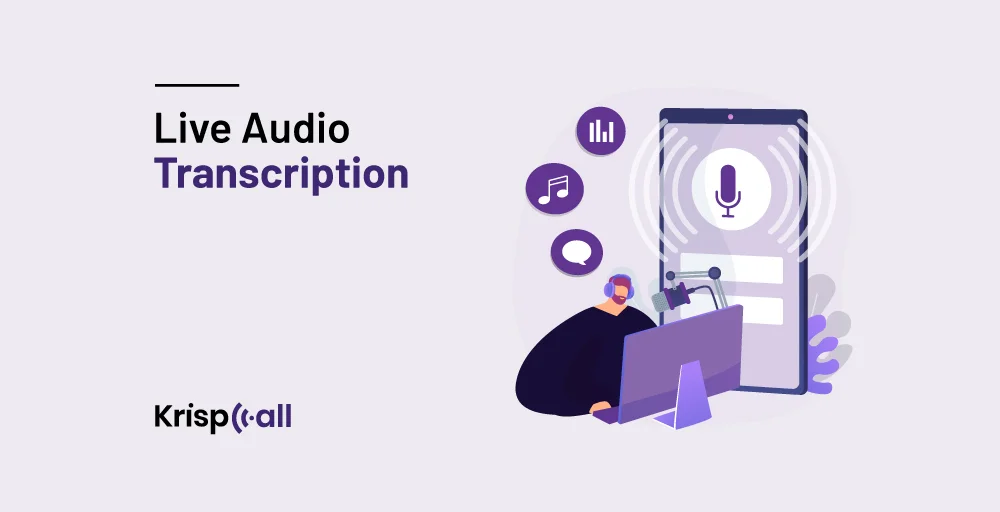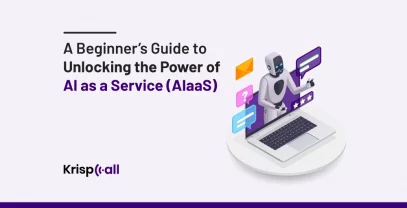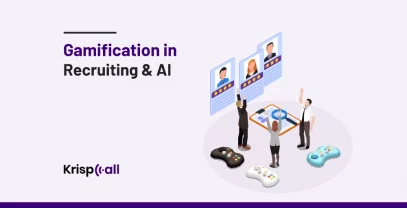Curious about how to quickly and easily turn audio into text without spending a lot? We’ve got you covered!
As more people create audio content, turning it into text has become important for reaching a wider audience. Fortunately, it doesn’t have to take hours. With the right tools, you can change any audio into text in just minutes.
In this blog, we’ll look at different ways to transcribe audio and help you find the best option for you. We’ll also give you a simple, step-by-step guide on how to do it easily.
🔑 KEY HIGHLIGHTS
- Live audio transcription is a tool that transcribes speech to text in real time.
- Businesses can use free live audio transcription tools such as Happy Scribe, oTranscribe, and Express Scribe to transcribe their spoken audio to text.
- It usually takes around four hours to transcribe one hour of audio. It takes around one hour to transcribe 15 minutes of slow audio files.
- Live audio transcription offers numerous benefits across various fields, including business meetings, lectures, educational training, content creation, and media production.
What is live audio transcription?
Live audio transcription is a tool that transcribes audio into text in real-time. It increases accessibility and communication efficiency and makes it easier for people to understand and record spoken content.
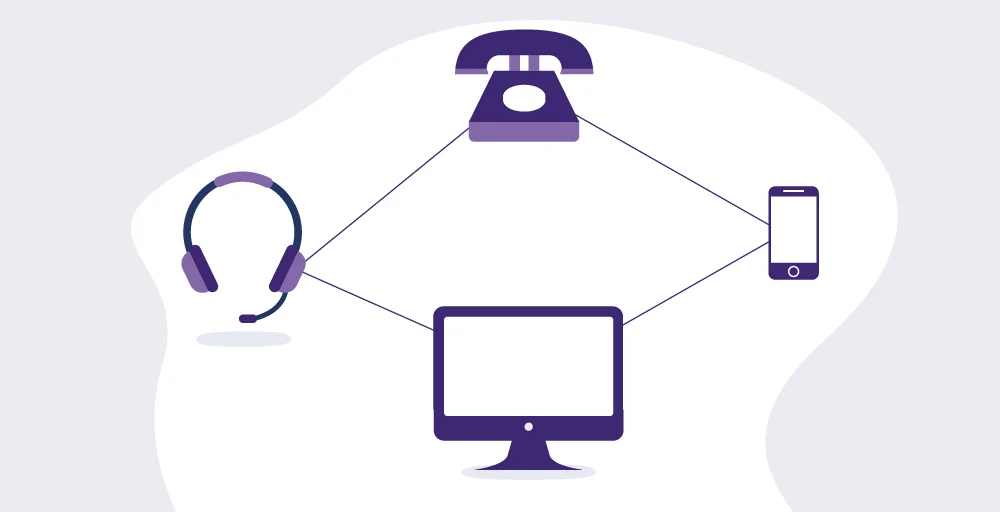
It basically works by converting speech into written text in the actual time. At first, it captures speech through a microphone and then processes it using an algorithm. The algorithm interprets and converts the spoken words to text, which is displayed on the screen or device that you are using to transcribe.
Audio transcription is widely used in live broadcasts, meetings, conferences, and educational environments. In addition, it is also used to help people who have hearing problems.
Benefits of live audio transcription
Live transcriptions are one of the best technologies. They not only assist businesses in transcribing speech but also empower individuals who are hard of hearing to communicate effectively.
Similarly, live audio transcription allows everyone to review the conversation later and make sure that they don’t miss any important details. This can be useful, especially in meetings, lectures, and interviews, as it provides a clear, searchable record. Overall, live transcription enhances communication and ensures that everyone can stay informed and engaged.
Let’s check out the benefit of live audio transcription;
1. Increase accessibility
Live audio transcription increases accessibility, making your content accessible to many people. People’s preferences vary; some prefer reading 📖, and some listen.
For example, if you have a podcast channel and upload your podcast on YouTube, then it is always a good idea to add subtitles or captions. This way, people who love listening will listen to your podcasts on YouTube, but those who don’t like listening to podcasts will read your transcribed blog about the same podcast. This way, transcribing speech to text will help your content reach a larger audience.
2. It saves time
Many businesses have to take accurate notes during important meetings and conferences, and sometimes, they have to transcribe the whole conversation. This process takes a lot of time and can be tiring as well.
However, with live audio transcription, businesses can quickly transcribe the spoken content into text. Compared to traditional manual methods, live transcription is much faster, allowing for detailed records to be created promptly. This efficiency ensures that no valuable information is missed and saves considerable time for all involved parties.
3. Cost-effective
With live audio transcription, businesses do not have to invest in transcription personnel and staffing training just to transcribe speech to text. Companies can eliminate the huge cost of buying and maintaining a high-tech transcription tool and cut staff training expenses.
Moreover, businesses can also use free live audio transcription tools such as Happy Scribe, oTranscribe, and Express Scribe to transcribe their spoken audio to text.
4. Enhance productivity
Live audio transcription is a powerful tool that eliminates the need for manual tasks like note-taking and writing. As it converts the audio in real-time, users do not have to worry about taking notes and can focus on other important things.
Voicemail transcription software also contributes to this efficiency by automatically transcribing voicemail messages, saving time, and ensuring important information is captured accurately.
5. Better engagement
Speech-to-text technology provides live captions of spoken content, making it easy for people who are deaf or hard of hearing to understand presentations, lectures, and conversations.
Furthermore, when the words are presented in text form at the same time as the audio, it greatly helps to explain the idea. It will enhance the idea, and people will be better engaged in that subject matter.
How to transcribe audio to text: Step by Step
Real-time transcription is the art of representing spoken audio in written form. It’s like having a sophisticated typer who listens to all your recordings and types them out at super speed.
Here’s how it works:
Step 1: Search for a good speech recognition tool
Before transcribing your audio into text, you need to find the best transcription tool that accurately converts your audio to text.
You need to invest in a proper tool with features like automatically pausing, playing back, and repeating content as needed. These features will help you pay close attention to various details like spelling, accuracy, and vocabulary.
Step 2: Upload a file with a clear sound
You have to choose or record a sound that you want to transcribe. This may be from different sources, such as interviews, podcasts, lectures, meetings, videos, or calls. Then, upload the audio to a dedicated transcription service or software program.
Step 3: Download and proofread the file
After transcribing the file from a transcription tool, download it and start proofreading it. You have to edit different fonts, sizes, and spacing. Similarly, edit and proofread whether the content is accurate and look for quality.
Correct mistakes, read the transcript aloud, look for spelling/grammar mistakes, and check whether there is consistency in style/vocabulary.
Step 4: Finalize the transcript
Finally, save the file in the correct transcription format. This could be a PDF file format, TXT, CSV, or whatever best works with your transcriptions. Similarly, upload the transcript file in a suitable format, label and categorize it appropriately, and share it accordingly.
By following these steps, you can efficiently and accurately transcribe audio to text using tools like Happyscribe, otTransribe, and Express Scribe.
3 Free Live Audio Transcription Tools
There are several live audio transcription tools that help you transcribe audio into text in real time. However, when it comes to choosing the best tools for your business, it is difficult, but don’t worry; we have listed out three that perform the best and are also free to use.
Here are three free live audio transcription tools;
1. HappyScribe
Happy Scribe is a text converter for those who do manual transcription. It offers various tools and shortcuts that assist you in speeding up a manual transcription.
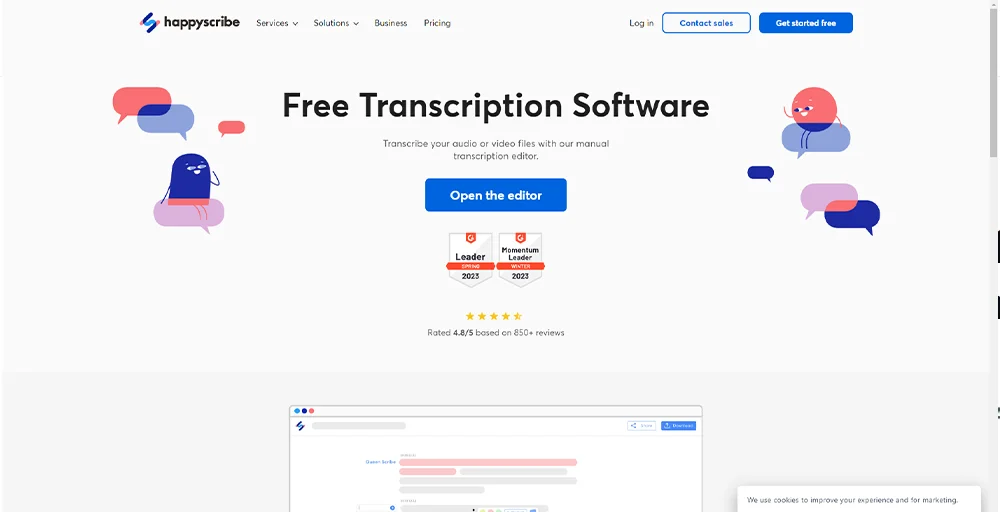
Its features, such as transcription and subtitling, are highly accurate and easy to use. However, to make the transcript suitable for publishing purposes, you need proofreading and editing.
HapppyScribe has free features that can be used anytime. However, it has limited features. It has AI transcription, subtitles, live transcription, translation, and free trial minutes. If you want to use the HappyScribe tool fully, you have to pay a certain amount. The price range is $10 to $29 per month.
Features of HappyScribe
- No limits on uploads
- Machine Translation
- Advanced shortcuts
- Import videos from YouTube and Vimeo
Pros 👍
- Tools and short keys that speed up the process of manual transcription.
- Easy to use.
Cons 👎
- Have to pay a certain amount for better features.
- HappyScribe doesn’t provide a complete, accurate file.
2. oTranscribe
oTranscribe is free and open-source software that you can access directly through your browser. Its simple interface allows you to manage the audio player and text editor in the same window without switching tabs to stop and start the audio.

Similarly, you do not have to register or provide any personal details to use it. You can simply go to the dashboard and upload an audio file to the app, which will display at the top of the screen. Below the audio is a text box where you type what is said.
In addition, this tool can integrate the controls for audio and word processing into one application.
Features of oTranscibe
- Play/pause
- Skip backwards and forwards
- Speed up
- Speed down
Pros 👍
- Pause, rewind, and fast-forward without taking your hands off the keyboard.
- No need to sign up
Cons 👎
- It doesn’t have an intuitive feature.
- It doesn’t provide accurate transcription.
3. Express Scribe
Express Scribe is a popular tool designed for professional transcribers. Its features, such as pedal control, variable speech, and speech-to-text engine integration, help you easily convert your audio file to text.
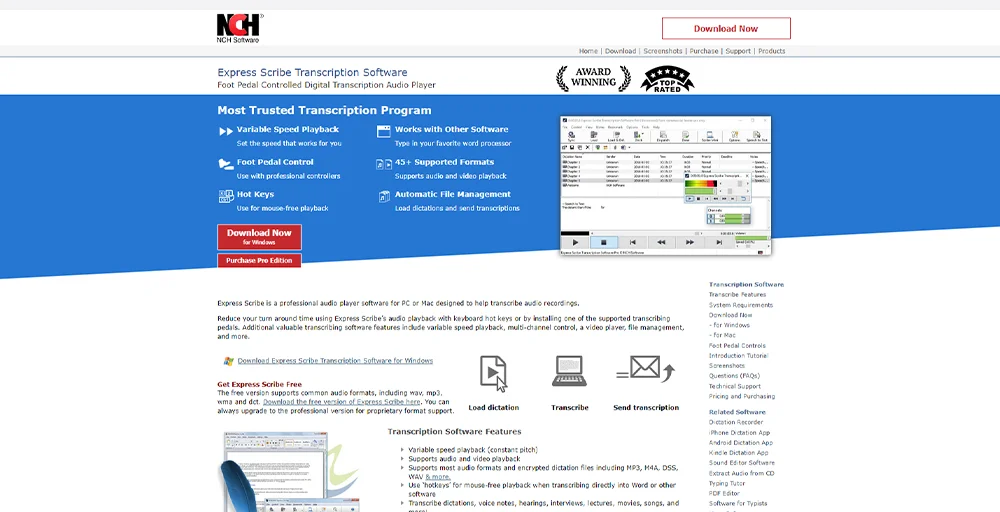
Express Scribe is free for Mac and PC platforms. It allows you to manage everything from your keyboard or through a foot pedal connection. It has a simple user interaction system and many hotkeys for improved performance.
The free version offers foot pedal support and can play various audio file formats, such as WAV, MP3, and WMA. Audio recordings can be automatically loaded from sources like CD, Email, LAN, FTP, local hard drive, and Express Delegate.
Features of Express Scribe
- Variable speed playback (constant pitch)
- Supports most audio formats and encrypted dictation files, including MP3, M4A, DSS, WAV & more.
- Works with other software
- Automatic file management
Pros 👍
- Simple and light software that is easy to install and use.
- The free version allows you to transcribe comfortably without a fee.
Cons 👎
- The free version does not offer free upgrades.
- Some features, like the foot pedal, maybe a little bit complicated to use at first.
How long does it take to transcribe audio into a text file?
It takes around four hours to transcribe one hour of audio. Likewise, it takes around one hour to transcribe 15 minutes of slow audio files.
However, transcribing audio files depends on various factors, such as the person, software, and sound quality. If a person is using transcribing tools for the first time, it could take hours to transcribe the audio file to speech.
Similarly, your service tool’s features can also determine transcribing time. If you have the best audio-to-text software, you can easily transcribe your audio within hours. Features like pedal foot can really help you transcribe audio quickly and efficiently.
Lastly, your recorded voice quality also determines how long you need to transcribe the audio. If you have the best audio quality and clear sound, you can easily transcribe without wasting time repeating the audio and simply transcribe in one flow.
Use cases for live audio transcription
There are numerous ways that live audio transcription can be beneficial to media projects and other communication activities. Here are just a few of the ways professionals across various industries can take advantage of live audio transcription solutions:
1. Business team meetings and conferences
Live audio transcription is much needed while attending important meetings and conferences. It is also important to take accurate notes🧾 during interviews, team meetings, and conferences.
Moreover, it can be time-consuming and tiresome to transcribe all those notes. But with the right audio captioning tool, you can easily record and transcribe that audio to text. By transcribing audio recordings of meetings, conferences, and presentations, you can easily review discussions, note action items, and refer back to important points later.
2. Media and content creation
Real-time transcription can benefit content creators, writers, authors, bloggers, podcasters, or film directors who want to convert voice memos, voice into text, or recorded ideas into books, blog posts, or articles.
They can use transcription services to write screenplays, audiovisual content, interviews, and media productions. Moreover transcripts are beneficial for writing content, proofreading, closed captions, subtitles, and search engine optimization.
3. Education and training
Educational institutions, such as schools, colleges, universities, and online learning platforms, can use transcription services to transcribe lectures, course materials, instructional videos, and other teaching resources.
Live transcriptions help students record their lectures, Q&A sessions, and seminars, which allows them to understand the course properly and read the transcript text whenever they want. Furthermore, it improves accessibility and learning outcomes for instructors and students.
4. Lectures and presentations
We might have noticed that many people complain about not getting the full benefit from lectures and presentations because a lot of information is available, and it sometimes becomes difficult to capture it all.
But with the Audio-to-text transcription tool, you can record the audio and transcribe the audio file. There are many free audio-to-text tools that can transcribe audio to text, saving you time and stress. Otherwise, you would be under pressure in lectures and conferences.
Conclusion
Live audio transcription is a useful feature that helps transcribe speech to text in real-time. It works by recording speech using a microphone and using advanced technologies to provide fast and accurate transcriptions. Media professionals and others in communication could benefit from live audio transcription for media projects and communication initiatives.
The use of live audio transcription has many advantages. It improves accessibility by ensuring that your content can be easily accessed by more people, especially those who prefer reading instead of listening. This can save time, and there are many free transcription options for those who want to transcribe audio for free.
Moreover, it is easy on the budget, enhances efficiency by enabling the participants to multitask, and makes for more active involvement by offering quick transcription.
FAQs
1. Is there an app that can transcribe audio to text?
Yes, there are many apps, such as Transkriptor, soundType AI, Notta, and VIIIo, that can transcribe audio to text.
2. Is there an easy way to transcribe audio?
The easiest way to transcribe an audio file is to use automatic transcription software like HappyScribe, Notta, Otter, and GoTranscript.
3. Is Live Transcribe free?
Some software or tools, like Happy Scribe, oTranscribe, and Express Scribe, provide free access to live audio transcriptions.
4. Can I transcribe the call?
Yes, you can transcribe the live call; there are different tools that offers live call transcription tools.

